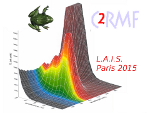To be able to date an object, one need to have a clock; that is a physical process, function of the time with an outstanding instant. In luminescence dating, the physical clock is the accumulation of absorbed energy, i.e. the dose, since the last heating. To obtain an absolute dating method, one need to calibrate the clock by a term reflecting the environment. It is made by measuring the dose-rate, or annual dose and by dividing the accumulated dose by the dose-rate. The dose rate received by an object has two components: an internal component (alpha and beta) from the object and an external component (gamma and cosmic ray)
In the case of archaeological artefact, external component can be measured, from soil sample in laboratory or directly using radiation measurements made at the artefact's location. Such a measurement is not possible for museum object due to the ignorance of it location before it entrance in the collection. This ignorance on the external dose rate contributes largely to the total uncertainty on age.
To reconstruct the local environmental radioactivity, two steps are required.
Firstly identify information that is available and which will be used as proxy of the dose rate. This information can be vague and we only have global values. To build our expert knowledge, we built a database of dose rates from a survey of the literature covering the major part of the planet. The information can be explain if we have some idea of the region of origin of the object. We are in this case dependent of the current dosimetrical and geological data on the area.
Secondly, quantify the uncertainty on the external dose rate using statistical tools. The recent development of the Bayesian approach and numerical simulations in luminescence dating are a valuable asset for this purpose.
Starting from the experience of 40 years in the dating on museum objects, we will discuss the different solutions used in our laboratory, advantages and disadvantages, as well as future research directions.
- Poster

 PDF version
PDF version
